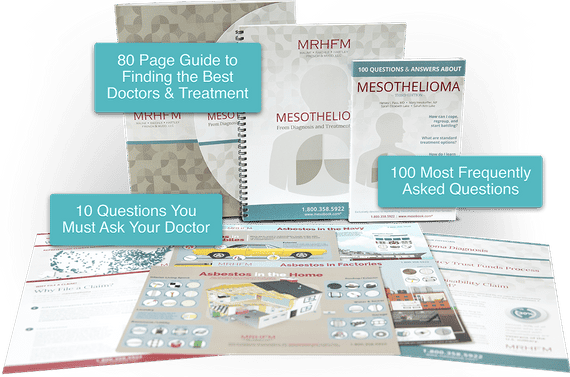
If you or someone you love has been diagnosed with mesothelioma, you want answers. You want to know where the best treatment options are and what can be done to help extend and maintain the best quality of life.
In our Mesothelioma Care Kit and Package, you can find answers, valuable resources, and more — for free.
Diagnosing mesothelioma can be difficult for a number of reasons. Symptoms often take a long time to appear, typically 10 to 50 years or more after exposure to asbestos, the symptoms of mesothelioma are common in several other illnesses. Because the symptoms are nonspecific, most patients are diagnosed with the disease at an advanced stage. Once diagnosed, your doctor will have identified one of three types of mesothelioma: pleural, peritoneal or pericardial. Each has its own distinct set of symptoms.
Pleural Mesothelioma affects the protective lining of the lungs, the pleura. It’s the most common location where the disease occurs — about 75 percent of all diagnosed cases are pleural. Those diagnosed with pleural mesothelioma will typically have the most treatment options available.
Peritoneal mesothelioma affects the protective lining of the abdominal cavity, the area of your body containing several organs including the stomach, intestines, kidneys, and liver. It’s the second most common location where mesothelioma grows—about 20 to 24 percent of all mesotheliomas occur here.
Pericardial mesothelioma affects the protective lining of the heart. It’s one of the rarest locations where mesothelioma occurs and accounts for about 1 percent of all cases. Because it’s rare, doctors don’t get to treat many patients with mesothelioma in this location and haven’t had as many chances to create effective treatments.
Knowing your cancer stage is an important part of your diagnosis because it determines how effective your treatment will be. Although there isn’t a specific staging system for mesothelioma, doctors have used a number of systems — TNM, Butchart, and Brigham — to divide the spread of cancer into 4 stages. For the most part, the earlier the stage, the less mesothelioma has spread, the easier it is for surgeons to remove — and the better your prognosis will be.
Mesothelioma treatment falls into one of two categories: curative or palliative. A mesothelioma specialist will prescribe the optimal treatment option based upon your diagnosis and staging.

Curative treatments seek to extend survival time by removing as much of the mesothelioma as possible. Typically multiple curative treatments are combined to achieve better results.
Palliative treatment addresses the symptoms of mesothelioma rather than the cancer itself. By easing symptoms such as chest or abdominal pain, doctors can help improve your quality of life.
Doctors never use a one-size-fits-all approach for mesothelioma treatment because the disease affects each patient so differently. Factors like the cancer stage, cell type, and location of the mesothelioma all play an important role in your treatment and will help determine how your doctor uses treatments like surgery, chemotherapy, or radiation therapy.
Surgery is most effective if you’re diagnosed with stage 1 or stage 2 mesothelioma as the disease hasn’t spread far beyond the lining of the lungs, abdomen, or heart. For stage 3 or 4 mesothelioma, doctors use surgery to remove obstructive tumors and improve quality of life.
Doctors use chemotherapy to shrink tumors, making their removal with surgery easier and more efficient. They also use it as a palliative measure to shrink tumors that restrict breathing or cause excessive abdominal pain.
Like chemotherapy, radiation therapy helps doctors remove tumors and relieve discomfort caused by their obstructive growth.
Multimodal therapy is a combination of two or more treatments. Doctors have greatly increased the life expectancy of patients with pleural and peritoneal mesothelioma using multimodal therapy.
Emerging treatments can benefit patients diagnosed with any stage of mesothelioma but may especially improve the prognosis for those with advanced-stage mesothelioma.

Your prognosis, an estimate your doctor makes on how your diagnosis will progress based upon how similar diagnoses have affected other people in the past. Factors including the cancer stage, cell type, and location of the mesothelioma all play an important role in determining which treatments your doctor recommends.
It’s important to remember that your prognosis isn’t set in stone. You can take action to change it by:

Mesothelioma Cancer Community, Sponsored by Maune Raichle Hartley French & Mudd, LLC.
Disclaimer: The information provided by MesotheliomaCancer.org is not a substitute for professional medical advice.
